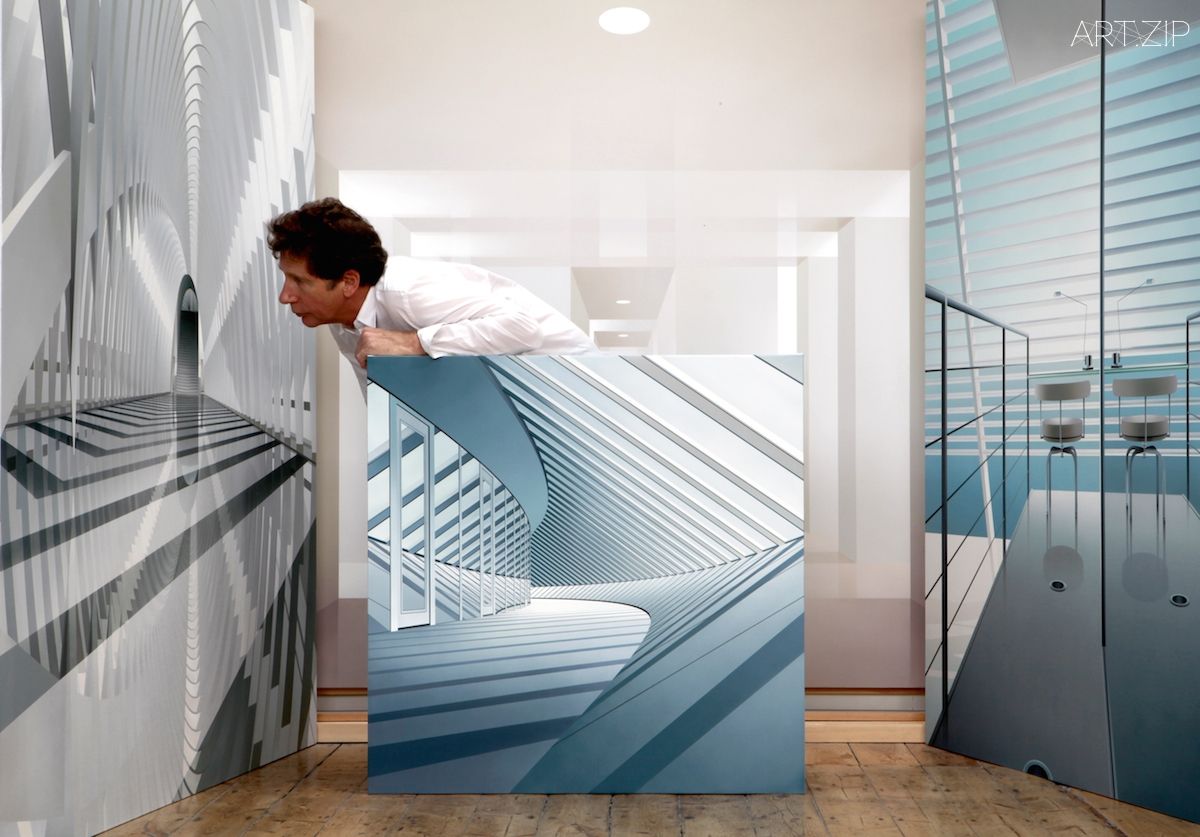
ART.ZIP: So to return to the question, what do you think is the relationship between your studio, your life and your work?
ART.ZIP: 這又帶我們回到之前提到的問題:你是怎麼看待工作室、生活與工作的關係的?
BJ: My life really is my work and my studio is where I can make the work and because I am craft-based rather than conceptually based, I do need the space for certain things. We have a bank of computers because all the drawings are made on computer and for the storage of all of my photographs – my sketchbooks are a camera and a photographic archive. Then I have a compressor here and I have another compressor downstairs, and I also have a very large machine for cutting stencils – because everything is done using stencils. So I need quite a lot of space. I am very lucky because I found this place and bought it. It was going to be sold very, very cheaply because of the recession in 1990 – but that is the way that I have bought all my studios. I have not rented a studio for over forty years. I used to rent.
I worked in somebody’s back bedroom for six months, I worked in somebody’s garage with a roof that sloped down a meter at one end and two meters at the other, so I had to bend down to paint on the left. I then worked in a derelict house someone was waiting to sell where there were rats and no water. I then worked in a stable where a horse had been and the only place that was vaguely warm was up a ladder, but it had no lavatory, so I had to have a bucket! Then I also had to have a bucket of water for mixing the paint, but in the winter it was so cold and so damp that the paint wouldn’t dry and the only way to heat it was a paraffin heater and paraffin heaters throw out huge amounts of water, so the walls were just running with water and condensation. I used to have to go home and sit in a bath for an hour just to get warm again.
So I have had a whole variety, but the first studio I bought was three pounds a week for rent! It was a long time ago, but at three pounds a week it was still cheap. Then I moved in. Then the estate agent said, well look the people who own it, it’s not worth a lot to them, three pounds a week is nothing, do you want to buy it? So I said how much? Four thousand pounds. So I bought my first studio for four thousand and then I sold it for fifty-thousand and I bought another one for fifty, which I have kept.
It was six meters by six meters and on one and a half floors with a courtyard and I could keep my bees in the courtyard. I used to leave the big doors open and the bees would come in the studio and fly around and then fly out and go in the hive. I lived just across the road from it. Then in 1995 I wanted to start making these large cityscapes, so I bought this studio where we are talking now. I wanted the cityscapes to be for the people. I was even thinking of putting a hole on this front wall so people walking past could look in and see how the painting was going, rather like you do with a building site – just a small window. But I didn’t do that. This studio was initially to make my cityscapes and the plan was always to go back to the smaller studio when I started making smaller, more intimate, personal paintings again. The one thing that my wife said to me was, now you’ve got a bigger studio don’t start making bigger work, and I said, I won’t! Of course I won’t! But of course, when you have a bigger studio, you make bigger work, but it means that very few people can house my paintings.
So what do I think about the space? The space has just got to be practical, but sometimes if you are lucky enough or you spend a long time looking, you do find a space that has some magic to it, although I do believe you can make the magic in a place. You can change the whole atmosphere by good acts, by getting good vibrations into a building, but some buildings just naturally feel right and for me, this just felt right. It was all about working – because these buildings were originally used by builders’ merchants. This building was wash basins and sinks and chimney pots, next door, Peter Blake’s, was paint and glass and Paul Huxley’s building opposite was hardware, hinges, nails, door fittings and then the courtyard was always shared and Peter has a little room in his studio which was for the horse to do the deliveries. They have got marks on the wall showing the horse’s height as it grew – this was its height after one year, two years, three years, fours years. It was the first builders’ merchants in Hammersmith in 1890 and we have a tunnel which goes under the courtyard, through Peter’s studio, right the way down to the river. When the builders were working on the courtyard, the courtyard collapsed and they fell into a tunnel and then they could go down the tunnel, which is an old brick tunnel and they realised they used to unload bricks there delivered by river. So this has always been a place for working people.
BJ: 我的生活就是我的創作,而我的工作室是我能夠進行創作的地方,因為我的創作是以手工技藝為基礎的,而不是以概念為基礎的,我的確需要空間來進行創作。這裡有許多電腦,因為所有的初期繪圖是在電腦上完成的,我也需要在電腦上存儲我的照片--我的草稿本就是一部相機和一個圖片庫。另外,這个工作室中有兩台壓印機以及一台非常大型的模板刻制機,因為我所有的創作都需要用到模板。所以我的確需要一個相對寬敞的地方。能夠找到並買下這樣的一個工作室,我感到非常幸運。在上个世紀90年代的經濟大蕭條的時期,這個地方以非常低廉的價格出售。逢低買入是我購置工作室的模式。在過去的四十年內,我沒有租用過工作室。我以前曾經頻繁地租用工作室。我曾經租用別人的臥室,在其中進行了六个月的創作;我在別人的車庫內工作過,而那個車庫的頂棚一端傾斜了一米,另一端傾斜了兩米,所以在繪畫的過程中我經常需要彎腰。我曾經在一個非常不堪的待售房屋內創作,那裡有老鼠,沒有自來水。我曾經在一個馬廄內創作,在那裡,稍微暖和一點的位置是一條梯子的上方,那裡也沒有洗手間,所以我需要常備一個桶!我另外需要一桶用以調配顏料的清水,但是,在冬天的時候,那裡非常的寒冷潮濕,顏料根本無法乾掉,唯一加熱的方法是使用煤油爐,但是煤油爐又會釋放出大量的水,所以牆面上又會有大量的水漬。那時我得回家泡一個小時的澡才能讓自己變得暖和起來。
我體驗過許多不同的工作室空間,而我第一个買下的工作室原本的租金為每週三英鎊!那是很久之前的事了,但就算是在那個時候,每週三鎊也是很便宜的。我搬了進去,當時那地產中介對我說,對於房東來說,每週三英鎊也不是甚麼大數目,你想不想買下這個房子?我問多少錢,他說四千鎊。所以我以四千英鎊買入了我的第一个工作室,而後以五萬鎊賣出,再用這五萬鎊買入了另一間。
那是一個六平米見方的工作室,是一間一層半高的房子,房子後面有一個小庭院,我用這個庭院來養蜂。我常開著後門,蜜蜂們就常在工作室中飛舞。我那時住在這個工作室的馬路對面。在1995年我開始了創作大型城市景觀繪畫,所以我買下了我們現在身處的這個工作室。我希望這些城市景觀是為了廣大觀眾而存在的。我甚至想過在牆上開孔,好讓路過的人們駐足欣賞工作室內的作品--就一個小小的窗戶就行了。但我並沒有這麼做。最初的計畫是,在完成了我的大型城市景觀繪畫系列之後,我會回到小型的工作室之中去,創作更小、更親切、更個人的繪畫。我的妻子總對我說,現在你有了更大的工作室,不要創作太大的畫作!我說不會!我當然不會!然而,當然,當你有了更大的工作室的時候,你就會創作更大的作品,但這也提高了收藏我的畫作的門檻。
那,我是怎麼看待工作室空間的呢?工作室空間必須是實際的,但如果你足夠幸運或足夠有耐性的話,你會找到一些奇妙的空間,當然我也相信你可以以自身的努力讓空間變得奇妙。你能夠通過一些措施改變整個氣場,為一幢建築帶來好的感覺,然而也有一些本來就讓我覺得親切的建築,身在其中就是感到愜意。所有這些與工作、勞動有關--我們身處的這建築原本就是建築商人使用的空間。這個空間原本裝滿了各種水盆、水池、煙囪頂管,隔壁彼得·布雷克的工作室里原本有着各種塗料、玻璃,而保羅·赫胥黎位於對面的工作室則有着各種硬件、轉軸、釘子、門配件等。這三個工作室之間的庭院一直是公用的,布雷克的工作室之中有一個小房間,原本用來安放運貨的馬匹。牆上有着許多記號,記錄著馬隨著年齡增長逐漸增加的高度。這是第一間位於哈默史密斯地區的建材店,建立於1890年,地下有一條隧道,穿過我和布雷克的工作室直至泰晤士河。有一次在庭院中施工時,庭院坍塌了,建築工人們掉進了隧道里,他們才發現這條隧道,並意識到舊時人們用這條老舊磚牆隧道前往泰晤士河邊,裝卸磚塊。所以這一直以來就是屬於勞動人民的空間。

